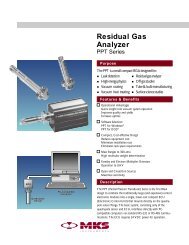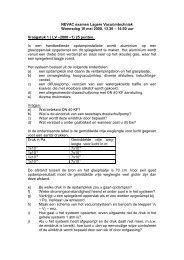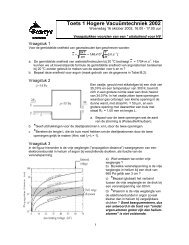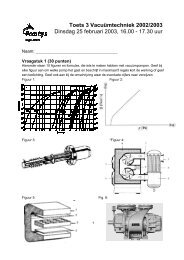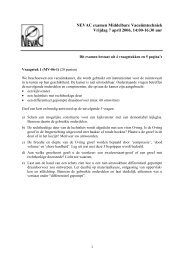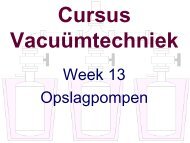Cleaning for Ultra- High Vacuum (UHV)
Cleaning for Ultra- High Vacuum (UHV)
Cleaning for Ultra- High Vacuum (UHV)
- No tags were found...
You also want an ePaper? Increase the reach of your titles
YUMPU automatically turns print PDFs into web optimized ePapers that Google loves.
<strong>Cleaning</strong> <strong>for</strong> <strong>Ultra</strong>-<br />
<strong>High</strong> <strong>Vacuum</strong> (<strong>UHV</strong>)<br />
Keith Middleman<br />
<strong>Vacuum</strong> Science Group<br />
ASTeC<br />
CCLRC Daresbury Laboratory
Outline of Presentation<br />
• <strong>UHV</strong> Limiting Factors<br />
• Why Do We Need To Clean <strong>for</strong> Accelerators<br />
• Methods to Reduce Outgassing<br />
• SRS <strong>Cleaning</strong> Procedure<br />
• Methods of Testing<br />
• Search <strong>for</strong> New <strong>Cleaning</strong> Solvents
Limiting Factors <strong>for</strong> achieving <strong>UHV</strong><br />
• Material Choice<br />
• Gas Sources<br />
• Contaminant: prevents vacuum system reaching required base pressure or<br />
introduces unwanted species into the residual gas.<br />
• Outgassing: The outgassing rate is the time-dependent rate at which gases<br />
and vapours are released under vacuum. This limits the ultimate pressure<br />
achievable and can introduce contamination into the vacuum system.
Why Clean <strong>for</strong> Accelerator <strong>Vacuum</strong> Systems<br />
• <strong>UHV</strong> Total Pressures Required ~ 1x10 -9 mbar<br />
• Maintain Satisfactory Lifetime Stored Electron Beam<br />
• Electron Scatter ∝ Atomic Number 2<br />
• Low presence of high mass species<br />
• Hydrocarbons < 0.1% Pump Lubricants < 0.01%<br />
• Stimulated desorption<br />
• Electron or Ion induced - Major gas source<br />
• Desorption Yield (Number of molecules per incident photon)<br />
• Maintain Clean In-<strong>Vacuum</strong> Surfaces<br />
• Prevent Particle Target Poisoning<br />
• Maintain Efficient Optical Properties <strong>for</strong> EM Radiation Transport
Methods to Reduce Outgassing<br />
• Bakeout - If the pressure is not low enough we can<br />
reduce the thermal outgassing rates by reducing the<br />
surface coverage N or the temperature T.<br />
• Beam <strong>Cleaning</strong><br />
• Passivation<br />
Oxide films<br />
Nitride coatings (TiN, BN)<br />
Active films (NEG coatings)
Methods to Reduce Outgassing<br />
• <strong>Ultra</strong>sonic <strong>Cleaning</strong> - widely used<br />
• Glow discharge<br />
• Electropolishing
SRS <strong>Cleaning</strong> Procedure<br />
CLEANING PROCEDURE<br />
EX-SITU BAKEOUT<br />
• Hot water jet with detergent<br />
• Surface stripping with alumina<br />
beads<br />
• <strong>Ultra</strong>sonic wash in hot Triklone<br />
• Vapour Wash in hot Triklone<br />
• Rinse with de-min water<br />
• Immerse in hot alkaline bath of P3-<br />
Almeco 36 at 60°C<br />
• Rinse in de-min water<br />
• Dry in warm, dust free air, bag and<br />
seal.<br />
• Leak check (< 10 -10<br />
• Bake to 250°C <strong>for</strong> 24 hours<br />
• Record RGA scan<br />
mbar l s -1 )<br />
Effective pre-treatment<br />
ensures outgassing rates<br />
are reduced to < 10-11 mbar<br />
l s -1 cm -2
<strong>Cleaning</strong> Facilities<br />
Water Jet and Detergent Phase
<strong>Cleaning</strong> Facilities<br />
Vapour wash
Testing - Is it ‘Clean’<br />
• Surface Analysis Techniques (Detailed Surface Composition)<br />
• AES - Auger Electron Spectroscopy<br />
• SIMS - Secondary Ion Mass Spectrometry<br />
• Scanning Electron Micrograph<br />
• Phenomenological Testing (Surface <strong>Vacuum</strong> Per<strong>for</strong>mance)<br />
• Measure Total Outgassing Rates - Total Pressure Gauge<br />
• Measure Partial Pressures - RGA<br />
• Stimulated Desorption (Friction, Electron or Ion Induced, Thermal)
Replacement of 1,1,2-Trichloroethylene<br />
• Why Change - Reclassification of 1,1,2-Trichloroethylene (Trike TM )<br />
• What is important to us - Thermal outgassing and ESD<br />
• Throughput method of measuring outgassing rates<br />
Q<br />
=<br />
P1<br />
− P2<br />
A<br />
⋅C<br />
• Comparative Tests - existing procedure proven <strong>for</strong> 20 years
Outgassing Measurement Facility
Thermal Outgassing Results<br />
Experiment In<strong>for</strong>mation<br />
Thermal Outgassing Rate<br />
Q (mbar l s -1 cm -2 )<br />
Blank Run<br />
No Contamination Cleaned with Trike<br />
Full Contamination. Cleaned with Trike<br />
Full Contamination. Cleaned with Lenium<br />
Full Contamination. Cleaned with Leksol<br />
Full Contamination. Cleaned with Novec HFE<br />
Full Contamination. Cleaned with IPA<br />
Full Contamination. Cleaned with Micro 90<br />
Full Contamination. Cleaned with Lancerclean<br />
9.3E-14<br />
7.9E-13<br />
9.3E-13<br />
2.8E-12<br />
9.3E-14<br />
7.5E-13<br />
7.5E-13<br />
3.7E-13<br />
4.6E-12
RGA Data - Thermal Outgassing<br />
Acceptable <strong>UHV</strong> Scan<br />
Hydrocarbon < 0.1%<br />
Pump lubricants < 0.01%<br />
Unacceptable <strong>UHV</strong> Scan<br />
Hydrocarbon ~ 25%<br />
Pump lubricants ~ 5%
RGA Data - Electron Stimulated Desorption<br />
Desorption Yield ~ 10 -3 molecules / e -<br />
Desorption Yield ~ 4 molecules / e -
Summary<br />
• Accelerators (storage rings) require <strong>UHV</strong><br />
• Need to minimise thermal outgassing and<br />
stimulated desorption<br />
• Requires a detailed cleaning recipe<br />
• Phenomenological Testing





